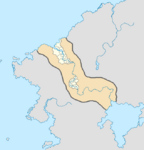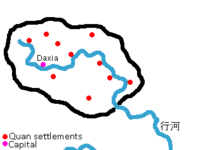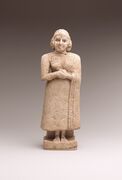Ancient Era: Difference between revisions
mNo edit summary |
|||
| Line 35: | Line 35: | ||
The beginning of the [[Quan]] dynasty emerged in the Hesterath Lowland in modern day XXX <!-- country where Quan is --> along the [[Hang river]] around 2300 BCE. In this period, and there was evidence of a fully developed writing system and a centralized government based in the city of [[Daxia]]. The Quan dynasty is the first XXX regime recognized by scholars though XXX historians insist that the [[Shan]] dynasty preceded it. The Quan dynasty practiced forced labour to complete public projects. There is evidence of massive ritual burial. | The beginning of the [[Quan]] dynasty emerged in the Hesterath Lowland in modern day XXX <!-- country where Quan is --> along the [[Hang river]] around 2300 BCE. In this period, and there was evidence of a fully developed writing system and a centralized government based in the city of [[Daxia]]. The Quan dynasty is the first XXX regime recognized by scholars though XXX historians insist that the [[Shan]] dynasty preceded it. The Quan dynasty practiced forced labour to complete public projects. There is evidence of massive ritual burial. | ||
In northern Naphtora, the Calidum civilisation emerged in 2500 BCE from the [[Furum]] culture which developed on the [[Herito river]] around 3000 BCE. The civilisation's city-states were placed neatly on grid patterns that were located up and down the Herito river. By 2000 BCE, the civilisation was unified under one rule labeled the [[Calidum Empire]] by XXX historians. This made Calidum the first {{wp|empire}} in [[Gentu]]. They formed trade routes stretching from modern day XXX <!-- western Oranland --> to the Hesterath Lowland. | In northern Naphtora, the Calidum civilisation emerged in 2500 BCE from the [[Furum]] culture which developed on the [[Herito river]] around 3000 BCE. The civilisation's city-states were placed neatly on grid patterns that were located up and down the Herito river. By 2000 BCE, the civilisation was unified under one rule labeled the [[Calidum Empire]] by XXX historians. This made Calidum the first {{wp|empire}} in [[Gentu]]. They formed trade routes stretching from modern day XXX <!-- western Oranland --> to the Hesterath Lowland and their navy dominated the [[Zestoric Sea]]. | ||
Across the Nullaric Oceans, the earliest known civilisation of [[North Domica]] appeared in the west coast of modern day XXX <!-- country in Creek -->. The Creek civilisation of decentalized city-states flourished around 2100 BCE, the most significantly was the city of [[Atontec]] which was abandoned for reasons unclear around 400 BCE. | Across the Nullaric Oceans, the earliest known civilisation of [[North Domica]] appeared in the west coast of modern day XXX <!-- country in Creek -->. The Creek civilisation of decentalized city-states flourished around 2100 BCE, the most significantly was the city of [[Atontec]] which was abandoned for reasons unclear around 400 BCE. | ||
Revision as of 12:24, 21 February 2022
This article is a work in progress. Any information here may not be final as changes are often made to make way for improvements or expansion of lore-wise information about Gentu. Please comment on this article's talk page to share your input, comments and questions. Note: To contribute to this article, contact User:Philimania. |
| Part of a series on the |
| History of Gentu and Gentish human history (Hodiernus epoch) |
|---|
| ↑ before Homo (Septun epoch) |
|
Prehistorical Era (one-era three-age system) |
|
| Ancient Era |
|
| Antiquity Era |
|
| Middle Era |
|
| Modern Era |
|
| ↓ Future |
The Ancient Era, also known as Ancient History is the period of time between the beginning of recorded history and the collapse of the Iron Age. The term Ancient Era is not to be confused with the Antiquity Era, the Era that followed the end of the Ancient Era.
During the time period of the Ancient Era (starting roughly from 3000 BCE), the world population was already exponentially increasing due to the introduction of agriculture. According to estimates, the world population increased exponentially in this period. In 10,000 BCE in prehistory, the world population had stood at 2 million, rising to 45 million by 3,000 BCE. By the rise of the Iron Age in 1,000 BCE, the population had risen to 72 million. By the end of the Iron Age in Gentu in 550 BCE, the world population is thought to have stood at 109 million.
Bronze Age
The Bronze Age begins with the end of the Cuprulithic Age. In most areas of civilisation, bronze smelting became a foundation for more advanced societies in places such as Hesterath, North Domica, Trimeshia, and Oranland. Modern historians have managed to identified 4 original civilisations which emerged in the time period.
| Early Civilisations |
|---|
|
- Enasan in Plevapotamia
- Quan in the Hesterath Lowland
- Calidum in northern Naphtora
- Creek in Norh Domica
The first civilisation emerged in Enasan in the region of Plevapotamia in southwest Hesterath, now part of modern-day XXX along the Exore river. By around 3000 BCE, XXX city-states had collectively formed civilisation with government, religion, division of labour, and writing. Among the city-states, Ire was among the most well known.
The beginning of the Quan dynasty emerged in the Hesterath Lowland in modern day XXX along the Hang river around 2300 BCE. In this period, and there was evidence of a fully developed writing system and a centralized government based in the city of Daxia. The Quan dynasty is the first XXX regime recognized by scholars though XXX historians insist that the Shan dynasty preceded it. The Quan dynasty practiced forced labour to complete public projects. There is evidence of massive ritual burial.
In northern Naphtora, the Calidum civilisation emerged in 2500 BCE from the Furum culture which developed on the Herito river around 3000 BCE. The civilisation's city-states were placed neatly on grid patterns that were located up and down the Herito river. By 2000 BCE, the civilisation was unified under one rule labeled the Calidum Empire by XXX historians. This made Calidum the first empire in Gentu. They formed trade routes stretching from modern day XXX to the Hesterath Lowland and their navy dominated the Zestoric Sea.
Across the Nullaric Oceans, the earliest known civilisation of North Domica appeared in the west coast of modern day XXX . The Creek civilisation of decentalized city-states flourished around 2100 BCE, the most significantly was the city of Atontec which was abandoned for reasons unclear around 400 BCE.
Iron Age
The Iron Age is the second and last age of the Ancient Era, spanning from 1000 to 550 BCE. The Iron Age overall was characterized by the prevalent smelting of iron with ferrous metallurgy and the use of carbon steel. Smelted iron proved more durable than earlier metals such as copper or bronze and allowed for more productive societies.
TBA
Development
Religion and philosophy
The rise of civilisation corresponded with the institutional sponsorship of belief in gods, supernatural forces and the afterlife. During the Bronze Age, many civilisations adopted their own form of religion. Usually, polytheistic Gods, who manifested human personalities, strengths and failings. Early religion was often based on location, with cities or entire countries selecting a deity, that would grant them preferences and advantages over their competitors. Worship involved the construction of representation of deities, and the granting of sacrifices. Sacrifices could be material goods, food, or in extreme cases human sacrifice to please a deity such as in XXX in XXX. Over time, a great variety of religions developed around the world, with some of the earliest major ones being XXX (around XXX BCE), XXX (XXXth century BCE), and XXX (XXXth century BCE) in XXX, and XXX in XXX.
TBA
Science and technology
In the history of technology and ancient science during the growth of the ancient civilisations, ancient technological advances were produced in engineering. These advances stimulated other societies to adopt new ways of living and governance. Sometimes, technological development was sponsored by the state.
TBA
Maritime activity
The history of ancient navigation began in earnest when men took to the sea in planked boats and ships propelled by sails hung on masts, like the XXX ship from XXX BCE.
TBA
Warfare
Ancient warfare is war as conducted from the beginnings of recorded history to the end of the Ancien Era.
The difference between prehistoric warfare and ancient warfare is less one of technology than of organization. The development of the first city-states, and then empires, allowed warfare to change dramatically. Beginning in XXX, states produced sufficient agricultural surplus that full-time ruling elites and military commanders could emerge. While the bulk of military forces were still farmers, the society could support having them campaigning rather than working the land for a portion of each year. Thus, organized armies developed for the first time.
TBA
Artwork and music
Ancient music developed in literate cultures, replacing prehistoric music. 'Ancient music' refers to the various musical systems that were developed across various geographical regions such as XXX, XXX, XXX, XXX, and XXX. Ancient music is designated by the characterization of the basic audible tones and scales. It may have been transmitted through oral or written systems. Arts of the ancient world refers to the many types of art that were in the cultures of ancient societies, such as those of ancient XXX, XXX, XXX, XXX, and XXX.
TBA
Timeline
TBA
By Region
TBA





